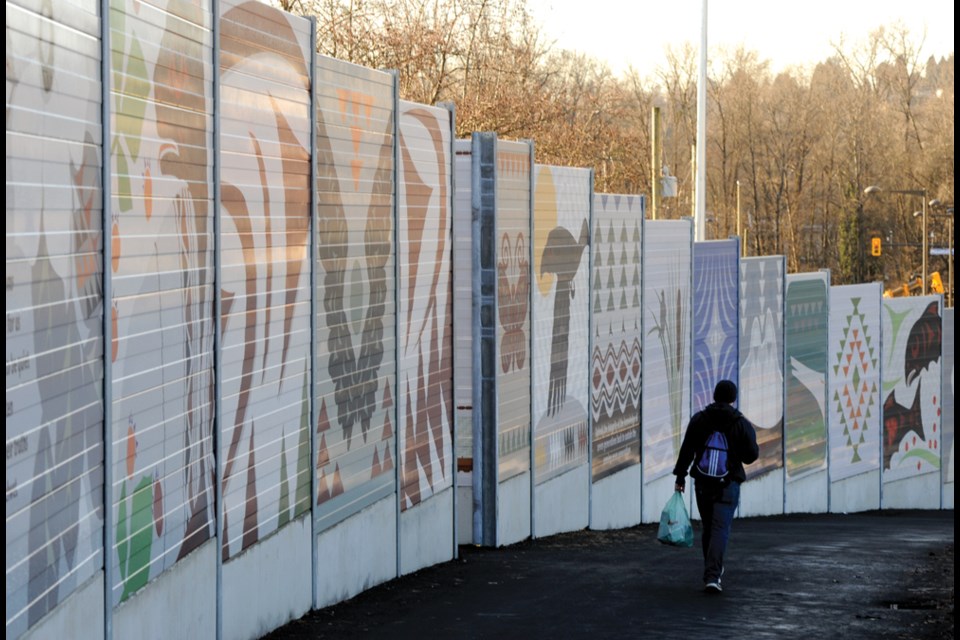A stunning expansive mural by two local Indigenous artists is the latest piece to be completed in the Lower Lynn Corridor Improvement Project.
Covering 28 sound wall panels along Fern Street by the recently completed Highway 1 interchange, the mural by Sḵwx̱wú7mesh (Squamish) carver Aaron Nelson-Moody (Splash) and weaver Angela George, merges both of their practices into a single cross-disciplinary art piece.
Collaborating on the piece titled Ncheḿús (“Coming Together”), Nelson-Moody and George focused the design on sharing the “rich and vibrant” history of the land with the surrounding community.
“We know that our ancestors and our ancestral ways ... come from the land, we are the land. So to have these designs emerging and rooted in those lands there, it really speaks to our oral history, these weaving patterns and designs,” George said. “And those drawings that Aaron Nelson-Moody did, they're holding knowledge, our ancient knowledge systems are held in our weaving designs and in our artwork.”
The province’s Ministry of Transportation and Infrastructure worked with both Sḵwx̱wú7mesh Úxwumixw (Squamish Nation) and the District of North Vancouver’s Public Art Program in a two-stage artist selection process, that resulted in four short-listed candidates, from whom Nelson-Moody and George’s concept was chosen.
The artwork features designs and patterns commonly found on weavings and carvings, seamlessly intertwined, along with poems and words from community members and family.
“One of the panels is asking us to witness the stories of our lands and waters. There is a traditional speaker wearing a woven blanket over one shoulder, that indicates he is speaking from the heart. And his head is covered in very sacred regalia to show that he is speaking with a good mind,” George said. “The words that are there on that particular sound wall, as you walk through, [are] inviting the people to come and witness the stories of land and the water.”
George said working with Nelson-Moody was an especially collaborative and engaging process, one which she found “easy.”
“Through that collaboration and openness that we shared, we were able to be enlightened, and really learn and grow as artists and as storytellers. So it was like, a ‘light-bulb moment’ [would happen] and [then we could] bring it to the next level, and blend our two ways of expressing together,” she said.
Momentum would build each time they got together, George said, adding as they overlaid each other’s work, a foundation would be built.
“It kind of goes back to the concept of in a long-house setting, in a ceremony, we would lay the blankets, and then if we were naming somebody or somebody is getting married, we would stand that person on top of that blanket, and we build on the foundation of that blanket … and then we would take one of those blankets, and we wrap a person in it.
“At the end [of the artwork], you'll see the very outside panels have the fringe of the blankets, and that's representative of where we've wrapped this work in our love, and in the purity of our woven blankets,” she said.
Along with the intertwining of different practices, Nelson-Moody said the piece also brought together and balanced male-female art forms.
“That was in a way, actually a really innovative aspect of the project. And it might not be that visible, but people in our community felt heard and respected in a new way with this project,” he said.
The artists tried to keep the designs simple, with references to local creatures from Squamish and Tsleil-Waututh territories, to allow for the “general public to really engage with it,” Nelson-Moody said, and with that, one might also find a surprise in the work.
“There’s kind of a little homage, if you will, to the Canucks. The canoe panel is kind of laid out like the Canucks logo, which is a funny little Easter egg,” he said.
But the designs also incorporate some “mysterious elements,” Nelson-Moody said, adding “it’s not a composition you would normally see in a painted, flat design,” nor, do you usually see such expansive pieces of art around the Lower Mainland from local Nations.
“Until [Musqueam artist] Susan Point put those pieces [the Welcome Gateways] up at Stanley Park, there wasn't really much of anything Coast Salish across the Lower Mainland. Our cousins on the Island have put up more wood carvings over the years, but on this side, there was almost no sign that we were still here,” he said.
“We’ve got so many more stories to share. And since first contact, we've been welcoming people. So we wanted this art to do that same thing,” he said. “And also, we are always innovating. We have cultures of innovation within our traditional culture. We've always been innovative. We've always tried to engage in new media, and we've always traded paints and materials from 1,000s of miles away.”
North Vancouver Recreation and Culture Commission Public Art Officer Lori Phillips said the piece has “artfully intertwined the traditional work of carvers, weavers and storytellers into a dynamic piece of contemporary art.
“Each of the 28 art panels has its own message to tell about nature, humanity and Coast Salish wisdom. I highly encourage community members to make this sound wall a destination for their next walk or bike ride.”
Charlie Carey is the North Shore News’ Indigenous and civic affairs reporter. This reporting beat is made possible by the Local Journalism Initiative.

.jpg;w=120;h=80;mode=crop)

